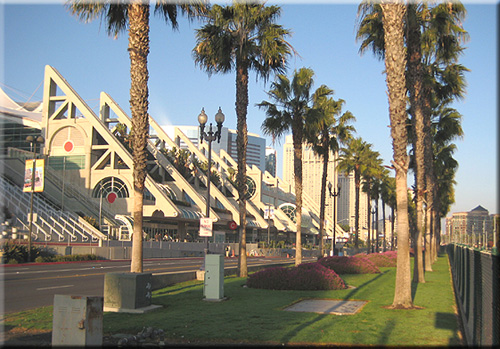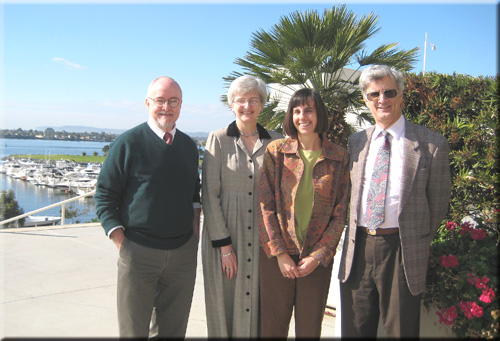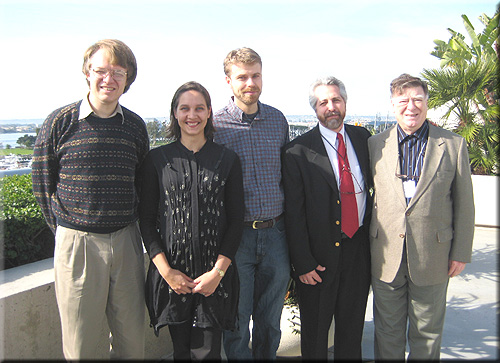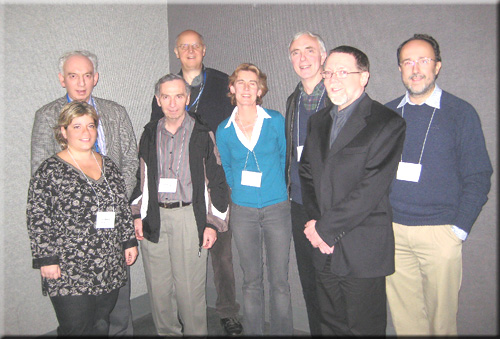ICHM-Sponsored Subsession of the Special Session on the History of Mathematics Joint Mathematics Meetings, San Diego, California (USA), 8 January, 2008
By Karen V. H. Parshall
This set of lectures, delivered by an international group of historians of mathematics, formed the first day of a two-day Special Session on the History of Mathematics at the Joint Mathematics Meetings held at the Convention Center in San Diego, California, USA.

The session was organized by Joseph W. Dauben (The Graduate Center of the City University of New York), Patti W. Hunter (Westmont College), Victor Katz (University of the District of Columbia), and Karen V. H. Parshall (University of Virginia)

and was comprised of—in the order of presentation—the following speakers and talks:
Mathematics and Mathematical Astronomy in Ancient India
Toke Lindegaard Knudsen Department of the History of Mathematics, Brown University, Box 1900, Providence, RI, 02912, USA
toke_knudsen@brown.edu
Since ancient times, both mathematics and mathematical astronomy, which belong to the same general grouping of Sanskrit knowledge systems, have been a subject of study in India. While Sanskrit texts on these topics were often written by the same people and share many mathematical methods, they differ in their presentation, as well in the topics treated. The links between scholarly mathematics and scholarly mathematical astronomy in India, e.g., how much of the contents of the Sanskrit mathematical treatises are put into play in mathematical astronomy, is a question that has not been widely investigated. With an eye to the relationship with the Indian mathematical treatises and the greater Hindu tradition. This talk looked at the contents of mathematical astronomy in ancient and medieval India.
A Different Sort of Sacred Geometry: The Medieval Analemma for Finding the Direction of Mecca
Glen R Van Brummelen, Box 760, Garibaldi Highlands, BC V0N 1T0, Canada
gvb@questu.ca
The direction toward which Muslim faithful must face for prayer, the qibla, garnered a great deal of attention from medieval astronomers. But, of course, the mathematical astronomy they inherited from India and Greece did not instantly provide a solution. One approach, attributed to one of the earliest and greatest Muslim scientists Habash al-Hasib, solved the problem geometrically, borrowing from the Greek tradition of the analemma. This technique, a clever reduction of the problem from three dimensions to two using several rotations within the celestial sphere, would be transformed into a popular trigonometric tool that may be thought of as a sequence of coordinate transformations on the celestial sphere. This talk surveyed the relevant history, and emphasize the beautiful mathematics of this and related methods.
A New Interpretation of Cardano's Liber De Ludo Aleae: Preliminary Report
Mary Sol de Mora Charles, Faculty of Philosophy, Universidad del Pais Vasco, 20018 San Sebastián, Spain
demora@leibnizsociedad.org
Girolamo Cardano (1501–1576) wrote the Liber De Ludo Aleae (Book on Games of Chance) sometime in the mid sixteenth century, although it was not published until 1663. Among the examples he uses is a game he calls fritillum, the meaning of which derives from its use in the Roman world as a cup for throwing dice onto a chess board. What Cardano offers in the De Ludo Aleae is a theoretical consideration of outcomes in games involving dice and cards. From a careful reading of the book, it is possible to see how Cardano went about considering the probabilities of various outcomes, including his mistakes as well as his successful results. The process through which a mathematician approaches his subject, and then tries to work out the theoretical consequences, served to focus this consideration of this particular early work on the theory of probability.
"The Net of Numbers": Combinatorics in Ancient India
Clemency J. Montelle, Department of Mathematics, University of Canterbury, Private Bag 4800, Christchurch, New Zealand
c.montelle@math.canterbury.ac.nz
The study of sequences, permutations, and combinatorics was considered essential by early Indian mathematicians because of their vital practical application in everyday life. Such mathematical results were of direct importance to the study of prosody, music, garland making, pharmacology and architecture, to name a few. As a result, Indian mathematical treatises are rich with vibrant worked examples which are instantly engaging to a modern audience, not only on account of their practical inspiration and the historical insight they offer, but also because of the mathematical ingenuity displayed when solving such problems. A range of examples and the ingenious ways in which they were solved was discussed in this presentation, taken chiefly from a twelfth-century work of Bhaskara II and from a fourteenth-century text Narayana Pandita, the relevant section of which is called "the net of numbers."
Navigating Between Triangular Numbers and Trigonometric Tables: How Thomas Harriot Developed His Interpolation Formulas
Janet L. Beery,Department of Mathematics, University of Redlands, Redlands, CA 92373, USA
janet_beery@redlands.edu
By 1611, Thomas Harriot (1560–1621) was developing finite difference interpolation methods, work that culminated in 1618 or later in his unpublished treatise, "De numeris triangularibus et inde de progressionibus arithmeticis: Magisteria magna." There, he derived symbolic interpolation formulas and showed how to use them to interpolate in tables. This treatise and its influence have been the subject of recent research by the author and Jacqueline Stedall. The interpolation formulas that appear in Harriot's manuscripts vary in notation, structure, and method of application. This talk focused on these largely undated manuscripts to show how Harriot may have developed and refined his methods over time.
Joaquim Gomes de Souza, A Controversial Ninenteenth-century Brazilian Mathematician
Ubiratan D'Ambrosio, Rua Peixoto Gomide, 1772 ap. 83, São Paulo, SP 01409-002, Brazil
ubi@usp.br
Joaquim Gomes de Souza, known by the nickname "Souzinha," was born in 1829, in the Northern State of Maranh&atidle;o, and died in 1863 in London, England. In his short life, he was learned in poetry, received a medical degree from the Sorbonne, did research in mathematics, and published short notes in the Proceedings of the Royal Society of London and in the Comptes rendus of the Paris Academy of Sciences. He was also a member of the Brazilian Parliament. He had also reportedly nearly completed a seven-volume treatise on nature, mind, and history. His life is remarkably adventurous. His collection of masterpieces of international poems, in their original languages, was published by Brockhaus in Leipzig. His contributions to mathematics were posthumously printed by the Leipzig firm of Brockhaus in a book of about 200 pages entitled Mélanges de calcul intégral. His results there are, however, not clear. The life and works of Souzinha raise many methodological questions for the history of mathematical research in the New World.
Introduction of Set Theory in Mexico: Preliminary Report
Alejandro R. Garciadiego, Departamento de Matematicas 016, Facultad de Ciencias, Ciudad Universitaria, UNAM, 04510 Mexico, D. F., Mexico
gardan@servidor.unam.mx
The foundation of a specific society, the creation of a research institute and the developing of the first specialized training school are some of the elements that marked the origins of a professional mathematical community in Mexico. It is logical and natural to attempt to determine the introduction of any branch of modern mathematics associated with a member of these institutions. Someone may have claimed to have lectured for the first time, or to have produced or translated the initial textbook on a subject. But other closely related academic disciplines—including philosophy, astronomy, and physics, among others—developed following similiar patterns. It is logical and natural to suggest that any member of these organizations could had claimed to have done exactly the same thing. In fact, Roberto Caso, who was associated with the philosophical research institute, translated into Spanish a textbook of set theory, namely Abraham A. Fraenkel's Set Theory and Logic (New York: Adddison Wesley, 1966). This lecture explored the various causes that motivated the introduction of set theory into Mexican culture and exposed the complex, intricate, and winding path that the subject took in making its way into Mexico.

The Early History of F = ma: Approaches to Central Force Motion at the Beginning of the Eighteenth Century
Niccolò Guicciardini, via Polibio, 5, 20144 Milano, Italy
niccolo.guicciardini@fastwebnet.it
It is generally held that Newton's approach to mathematized natural philosophy was geometrical and that Continentals should be credited for the algebraization of dynamics. This talk considered a group of manuscripts concerning the application of fluxions to central force motion that Newton wrote in the early 1690s. From an analysis of these, it is apparent that Newton wrote the second "axiom or law of motion," F = ma, in calculus terms, and that he applied it, via an algorithm of his own contrivance, to the motion of a "body" acted upon by a central force. This talk presented evidence not only for the fact that Newton communicated this formulation to his acolytes, including Abraham de Moivre and John Keill, but also that Newton's formula for central force motion reached the Continent where it was received and used by Johann Bernoulli. These manuscripts and the story of their transmission teach us several lessons about Newton's agendas, about his communication codes, and about the relationships between British and Continental mathematicians.
Richard Dedekind (1831–1916): A Path-breaking Mathematician
Israel Kleiner, Department of Mathematics and Statistics, York University, Toronto, Ontario M3J 1P3, Canada
kleiner@rogers.com
This talk focused on some of Dedekind's path-breaking conributions: the founding of algebraic number theory, the definition of the real numbers in terms of Dedekind cuts, the establishment (jointly with Heinrich Weber) of Riemann's algebraic function theory on a rigorous (algebraic) basis, and the definition of the natural numbers in terms of sets.
Publishing Research: Specialized Mathematical Journals in Italy (1850–1914)
Laura Martini, Via D. di Boninsegna, 2, 53100 Siena, Italy
lauramartinisiena@gmail.com
During the first half of the nineteenth century, journals devoted to the mathematical sciences were founded in a number of national venues, especially in France, Germany, and Great Britain. On the contrary, in Italy, local societies and academies provided the primary publication outlets for mathematical research at this time. In addition, general interest periodicals, usually established and kept alive by small groups of scholars, occasionally published original mathematical research. The first mathematically oriented journal in Italy started only in 1850 when Barnaba Tortolini (1808–1874) founded the Annali di scienze matematiche e fisiche. In subsequent decades, a number of specialized mathematical journals appeared in Italy. This talk discussed this evolution beginning with Tortolini¡¯s Annali and moving to the Annali di matematica pura ed applicata (founded in 1858), the Giornale di matematiche (founded in 1863), and the Rendiconti del Circolo matematico di Palermo (founded in 1887). It also outlined the research interests of Italian mathematicians by analyzing the mathematical contributions to the three latter specialized journals from their respective foundations to the outbreak of the First World War.
Lord Kelvin: The Irish Connection
Raymond G Flood, Kellogg College, 62 Banbury Road, Oxford, OX2 6PN, England
raymond.flood@conted.ox.ac.uk
This talk opened with an account of Kelvin's father, James Thomson, whose first job was as a farm labourer near Belfast, Northern Ireland where Kelvin was born. James went on to be Head of Mathematics at Belfast Academical Institution, and then Professor of Mathematics at Glasgow University. He played an enormously influential role in the development of Kelvin's religious, scientific and political views, as well as being central to Kelvin's success in obtaining a Chair at Glasgow. The talk also included an account of Kelvin's personal interaction with his elder brother, also James, who was an engineer and who returned to work in Belfast in 1851, being Professor of Engineering at Queen's University, Belfast, from 1854 until he moved to join Kelvin in Glasgow in 1873. Kelvin's sisters also returned to live in Belfast, and he was himself a frequent visitor, always concerned with Belfast and Irish affairs. December 2007 marked the centenary of Kelvin's death, making the occasion of this talk an appropriate point to review the Irish dimension of his life so frequently overlooked.
Formulas, Concepts, and the "Jacobi Limit": Observations on Change in Late-nineteenth-century Mathematics: Preliminary Report
Tom Archibald, Department of Mathematics, Simon Fraser University, Burnaby, BC V5A 1S6, Canada
tarchi@sfu.ca
Many historians have observed that the eighteenth century was a time when the recognition of patterns produced results directly from hand calculations. Around 1840 Jacobi remarked that the limitations of this calculational method as a source of discovery were becoming apparent. Reading with hindsight, his remarks seem prophetic, directly preceding a move to a more "modern," conceptual viewpoint. This shift has been described by several writers in terms of a change from a formula-based to a concept-based mathematics. However, formulas have a variety of purposes: they may be used to classify objects or to represent generic objects. The distinction between the older and the newer views is thus difficult to summarize in terms of the distinction between formulas and concepts or structures. This talked considered the distinction between formulas and concepts against the background of differing views about the ontological status of mathematical objects. Some writers viewed mathematical objects as naturally occurring, so that their relations were objectively given, and not merely subject to the whim of the mathematician and the requirements of consistency. This viewpoint has several advantages for the historian, while still shedding light on the distinction in question.
Jacques Hadamard (1865–1963) and the Calculus of Variations: Preliminary Report
Craig G. Fraser, Institute for the History and Philosophy of Science and Technology, Victoria College, University of Toronto, Toronto, Ontario M5S1K7, Canada.
cfraser@chass.utoronto.ca
Jacques Hadamard's Leçcons sur le calcul des variations was published in 1910 with the assistance of his former student Maurice Fréchet (1878–1793). This work included advanced topics in Weierstrass's theory of sufficiency, the study of constrained extrema and the existence of solutions to problems of optimization. Although the subject in this period was dominated by German researchers, Hadamard's book also drew on contributions of his fellow countrymen Joseph Serret (1819–1885), Camille Jordan (1838–1922), Gaston Darboux (1842–1917), and Édouard Goursat (1858–1936) as well as dynamical work of Paul Appell (1855–1930) and Henri Poincaré (1854–1912). This talk gave an account of Hadamard's Leçcons, situating his theoretical conceptions in the context of contemporary research in the calculus of variations.
How Influential Was Mechanics in the Development of Neo-classical Economics?
Ivor Grattan-Guinness, 43 St Leonard's Road, Hertford, Herts SG14 3JW, England
eb7io6gg@waitrose.com
It is well known that classical mechanics played a significant role in the thought of several major economists in the neo-classical tradition from the 1860s to around 1910. Less well studied are the particular parts or features of mechanics that exercised this influence, and the total extent of the impact. This talk reviewed these matters and presented an argument that the effect was less than might be imagined, even perhaps by the economists themselves.
"Anti-aircraft Guns All Day Long": Computing for the Ministry of Munitions
June E Barrow-Green, Faculty of Mathematics and Computing, Walton Hall, Milton Keynes, MK7 6AA, England
J.E.Barrow-Green@open.ac.uk
From January 1917 until March 1918 Karl Pearson and his staff of mathematicians and human computers at the Biometric Laboratory worked tirelessly on the computing of ballistic charts, high-angle range tables and fuze-scales for A. V. Hill and members of the Anti-Aircraft Experimental Section. Things did not always go smoothly—Pearson did not take kindly to the calculations of his staff being questioned—and Hill sometimes had to work hard to keep the peace. This talk looked at the contribution of the Biometric Laboratory to the war effort, setting it into the broader context of the mobilization of mathematicians in Britain.
L. S. Pontrjagin's Letters to I. I. Gordon: Preliminary Report
Evgeny I Gordon, Department of Mathematics and Computer Science, Eastern Illinois University, 600 Lincoln Ave, Charleston, IL, USA
yigordon@eiu.edu
This talk surveyed the contents of the letters of the eminent Russian mathematician, L. S. Pontrjagin, to the topologist, I. I. Gordon. Pontrjagin advised Gordon's doctoral research in 1933–1935. In this thesis, the ring of cohomologies was introduced independently of J. W. Alexander and A. N. Kolmogorov and a totally different approach was used. The 159 letters, which are already published in Russian, cover the period from 1937 to 1969. They touch on many interesting episodes of the history of Soviet Mathematics, including the period of World War II, the influence of the Iron Curtain on contacts between Soviet and Western mathematicians, relations among the leading mathematicians N. N. Luzin, A. N. Kolmogorov and P. S. Alexandrov and many others. The letters of 1937–1938 contain a list of important problems in topology of that time from the point of view of Pontrjagin. An interesting discussion of the homotopic classification of continuous maps is contained in the letters of 1945–1951. The history of Pontrjagin's transition from topology to dynamical systems under the influence of the eminent physist A. A. Andronov and the work of Pontrjagin's group on the Maximum Principle are also discussed in the letters.
Mathematicians Fleeing from Hitler's Germany
Reinhard Siegmund-Schultze, Department of Mathematics, Adger University College, 4604 Kristiansand, Norway
reinhard.siegmund-schultze@uia.no
This talk surveyed the emigration of mathematicians from Europe after 1933 and the ensuing shift of the world center of mathematics from Europe to the United States, arguably the most important historical result of Nazi rule for mathematics. The book (to be published in an expanded English translation 2008) on which this talk was based gives the first account of emigration in mathematics from Europe during the Nazi period. The discussion is restricted to German-speaking emigration, which, however, was by far the most important part of the overall emigration, only partly matched by Polish, and, to an even lesser extent, French and Italian emigration. Emigrant-mathematicians discussed in the book include Emil Artin, Richard Courant, John von Neumann, Emmy Noether, Richard Brauer, Richard von Mises, Issai Schur, Hermann Weyl, and many others. Although the book's main focus is on emigration, it also gives a cursory account of persecuted mathematicians who did not or could not escape from Europe, and of some of the mechanisms of Nazi rule in Germany.
